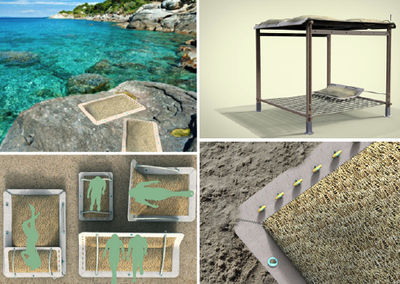Environment: at the XXI Triennale in Milan, eco-structures made from sea plants
12/5/2016
From Posidonia beach-cast litter comes an ecostructure for seaside decor. A first model, developed with the collaboration of ENEA, will be on exhibit until September 12, 2016 at the XXI Triennale in Milan.
 Mats and rugs that can be assembled together, sun screens for gazebos, walkways, borders for pathways: from the collaboration among ENEA, the University of Rome La Sapienza and the Egadi Islands Marine Protected Area comes “Medonia”, a multifunctional ecostructure made from sea plants collected from emerged beaches and used to stuff casings made of biodegradable or recyclable materials. Medonia is the outcome of a research project combining the safeguard of Posidonia seagrass with the design of products for seaside activities. It stems from the activities carried out under the ENEA project GE.RI.N (Natural Resource Management) in the framework of the program “Eco-innovazione Sicilia” for a sustainable tourism in the Egadi Archipelago, already awarded with the Green Coast Award 2013 and the Prize Smart Communities –SMAU 2015.
Mats and rugs that can be assembled together, sun screens for gazebos, walkways, borders for pathways: from the collaboration among ENEA, the University of Rome La Sapienza and the Egadi Islands Marine Protected Area comes “Medonia”, a multifunctional ecostructure made from sea plants collected from emerged beaches and used to stuff casings made of biodegradable or recyclable materials. Medonia is the outcome of a research project combining the safeguard of Posidonia seagrass with the design of products for seaside activities. It stems from the activities carried out under the ENEA project GE.RI.N (Natural Resource Management) in the framework of the program “Eco-innovazione Sicilia” for a sustainable tourism in the Egadi Archipelago, already awarded with the Green Coast Award 2013 and the Prize Smart Communities –SMAU 2015.
Among the best-practices of the Project GE.RI.N is the development of eco-friendly structures made from recovered Poseidonia beach cast litter, also with the purpose of re-establishing, using an experimental technique, seagrass shoots on the sea bottom. This procedure and the first stuffed casings, later patented by ENEA, inspired the utility model Medonia. In addition to providing an ideal habitat for many animal and vegetal organisms, Posidonia can absorb significant amounts of CO2 and 2 square meters of seagrass meadow can produce a daily amount of up to 20 litres of oxygen while effectively protecting coastal lines from erosion.
Posidonia beaching occurs in over 60% of the Mediterranean coastlines and is considered one of the priority issues in the Mediterranean environment, causing citizens, tourists, operators of bathing establishments and municipalities to bear the high costs of cleaning and disposal.
The project Medonia has succeded in turning Posidonia litter into a resource for innovation with the objective of reclaming beaches and rock areas for tourism purposes, with an eye to environment protection and safeguard of the territory, in a circular economy approach embracing eco-design and sustainability. It will be on exhibit until September 12, 2016 at the XXI International Triennale Exhibition in Milan (21st Century Design After Design), within the exhibition “New Craft” held at the Fabbrica del Vapore.
“This first phase of the project, to be conducted at the Egadi Islands Marine Protected Area under the patronage of the Kyoto Club and the Green Building Council- Sergio Cappuccio at ENEA pointed out- was given a grant by the Lazio Region to implement good practices on the territory with the prospect of starting a spin-off. In addition, thanks to the University of Rome La Sapienza-he concluded-the project has obtained sponsorships from leading companies in the sectors of design oriented products and innovation technology, such as Unopiù, Plastitex and Gottifredi Mattioli, that will develop the prototypes on the islands of Favignana and Marettimo.
Photo Gallery - [download images]
For more information please contact:
ENEA contact person: Sergio Cappucci – ENEA Casaccia Research Center - sergio.cappucci@enea.it
EAI – Energia Ambiente Innovazione: Multifunctional structure made with seagrass wrack: A patent of the GE.RI.N project
XXI Triennale di Milano - CALL UNDER 35
Medonia web site: medonialab.com
